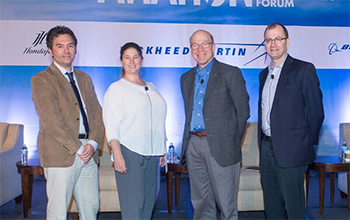Researchers Discuss Need for Teamwork Between Humans and Machines Written 7 June 2017
Panelists: Moderator Dale Richards, senior research fellow in human factors, Coventry University; Danette Allen, senior technologist, Intelligent Flight Systems, NASA; Andrew Lacher, senior principal and unmanned and autonomous research strategist, The MITRE Corp.; David Mindell, founder and CEO, Humatics Corp., and professor, Massachusetts Institute of Technology
by Hannah Godofsky, AIAA Communications

The relationship between humans and machines is changing to one in which humans and machines need to work as a team, a panel of experts said June 7 at the 2017 AIAA AVIATION Forum in Denver.
“Any place where we’re transitioning from automation to autonomy is an opportunity to team between multi-agents, humans and machines in the system,” said Danette Allen, a NASA senior technologist for Intelligent Flight Systems and head of the autonomy incubator at NASA’s Langley Research Center.
She said NASA needs automation.
“All of these new missions have one thing in common, whether they’re Earth-bound or space-bound or planetary-bound, they all need very complex automation and perhaps even autonomy to succeed,” Allen said. “Because we’re talking about distances beyond cislunar. We’re talking about high-latency, very cluttered environment — safety-critical, time-critical systems and decisions that have to be made in uncertainty.”
Andy Lacher, a senior principal at The MITRE Corp., elaborated on human and machine teamwork.
“What we’re really talking about is a partnership, where the human is the senior partner, but the human and the machine have to work together,” he said.
But, he stressed, the human has to be alert and aware in order for a partnership to be safe and reliable.
“The key here is the human can’t be the safety net for the automation,” Lacher said. “The human has to remain vigilant, because when the machine can’t handle it, it hands it back to the human. And sometimes it’s at the most critical or the hardest part.”
Lacher cited examples like automated driving features or underwater robotic exploration to explain why humans need to stay aware even when some aspects of machine operation have been automated.
David Mindell, founder and CEO of Humatics Corp., said there are benefits of working with automated systems as a team.
“Computer chess programs learned how to beat people more than a decade ago,” he explained. “But actually today, the best chess players are people with computers, and they can beat either computers or people alone.”
Mindell gave an example of archeologists who at first were skeptical of a role for automation and robotics in their field but later came to embrace autonomous data collection for their studies.
“We gave them a level of overview of a problem that they couldn’t get in a different way,” he said.
